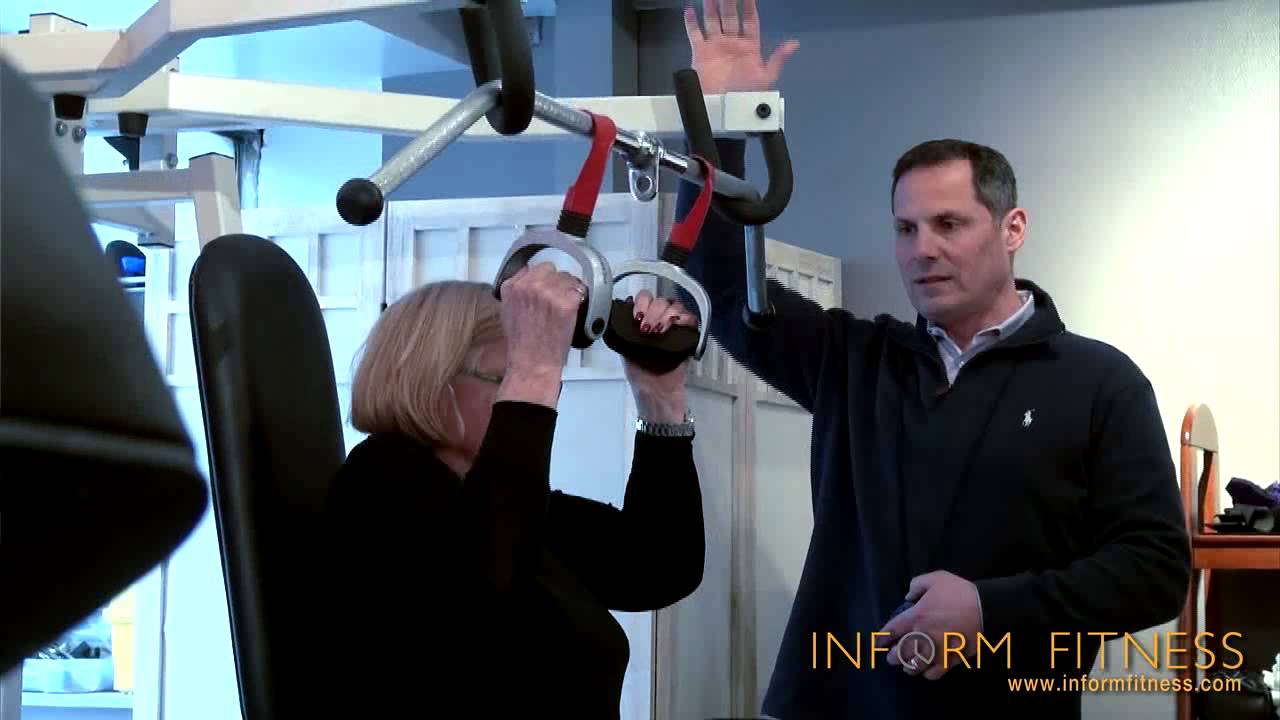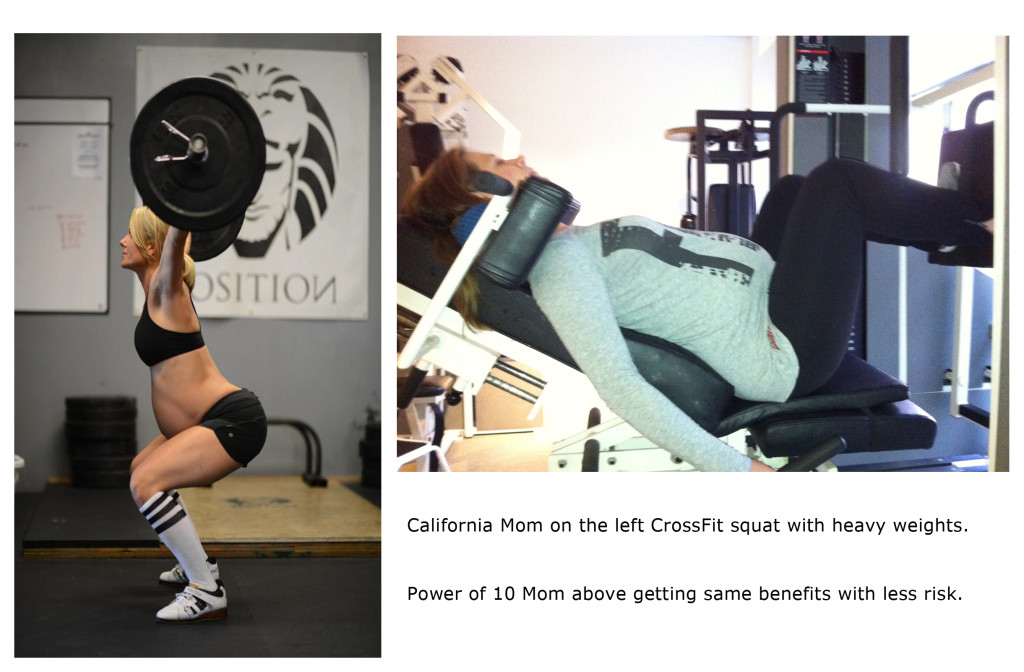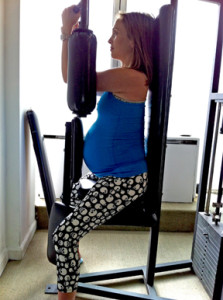Lifting Weights at 90 Years Old



![]()
I’m a regular coffee drinker, and now that reports claim that coffee is actually a good thing, I no longer feel the need to be discreet about my caffeine addiction…um…attraction.
Join me in coming out of the java closet; let’s talk about coffee.
Always on the lookout for interesting and new facts about health, food, and exercise, to share on our “Fact of the Week” I regularly come across information about coffee while researching and writing our posts. If you follow us on Facebook, you’ve probably seen some of my caffeine related posts, along with a lot of other quirky, scientific facts.
Reading the latest research findings that stream across my screen helped me to realize that coffee is actually as complex a topic as wine. Being a fairly laid back guy, the last thing I need is to ingest a depressant that’s going to slow down the functions of my central nervous system – I decided to choose coffee over wine for my research.
The biochemist in me is driven to explore caffeine. Coffee is a $70 billion industry worldwide and the second most tradable commodity after oil. I simply can’t ignore this fascinating molecule. Caffeine is the most widely used (or abused) psychoactive addictive drug in the world – and it’s not regulated like alcohol or drugs – a fact supporting my claim that it’s a worldwide addiction.
I want to explore:
I’m fascinated by my original research findings. I never thought of drinking coffee as an ancient ritual, or about the fact that it’s one of the most consumed foods in the world. Many of you are as curious as I am about coffee, so let me do the research and share my discoveries with you in periodic blog posts and in some “Facts of the Week.”
Until recently, I was not much of a coffee drinker. I grew up in a home enjoying the delicious aroma of my parents’ daily morning brew, but I didn’t have the desire to drink it. Coffee simply smelled much better than it tasted. I will admit that there were times during college when coffee was an absolute necessity to get me to my morning classes. Later, I became a social coffee drinker, occasionally having a cup of coffee after dinner while out with friends, or as a needed energy boost when balancing entrepreneurship with husbanding and fatherhood. Even so, I hadn’t become a regular coffee drinker. Invested in good health, I believed what I had always read and heard about the evil that brews from coffee.
A decade or two later, studies started revealing that drinking coffee in moderation is actually beneficial. While this was an interesting discovery, I still wasn’t hooked on the deliciously aromatic beverage.
To kick off my first “Coffee Chat” post, I’ll share with you the story of how coffee became a part of my daily routine.
It’s my oldest son’s fault – he got me started on coffee when he was three.
While my wife was pregnant with our second child, she was restricted to bed rest. We decided it would be best if she stayed with my parents in Long Island while I worked in the city. I would take Fridays off to spend the weekend visiting and to spend time with my son.
Early one morning, on our way to a nearby park, my son and I stopped at a local cafe to get a cup of coffee for me, and a soda water for him. When we arrived at the park, we sat on a bench like two regular guys, drinking our morning brews. It was a bonding moment. I didn’t realize just how much that moment meant to him until the following Friday.
The very next Friday, we headed to the park once again. This time I didn’t need a java jolt, so I planned to forego the café that morning. I got another kind of jolt instead. When my son realized that we were skipping the coffee and soda water, he threw a fit. I explained to him that I didn’t want coffee that morning, yet he was determined to recreate the previous Friday morning experience exactly as it had happened before. Anyone who has spent time with a three year old won’t blame me for having immediately rerouted back to the coffee house.
By the time my second child was born, I was trained into a habitual morning java drinker.
Here I am today, a serial coffee drinker, and a health and fitness expert whose entire business is based on making safe choices. So yes, I want to make sure that my new habit is not harmful, motivating me to explore the scientific, cultural, and environmental aspects of caffeine. I hope you’ll join me on this journey of discovery. If you haven’t subscribed to this blog yet, just click on the link to the right at the top of the page, and let’s get started.
![]()

There, I said it and I feel better to have that off my chest.
Inconclusive medical and scientific studies along with supporting media hype, drive what doctors prescribe, how coaches and personal trainers instruct, athletes train, and the average motivated man or woman engages in working out.
Though most medical professionals are educated and well intentioned, many are ill informed regarding exercise. An abundance of dramatically different workout protocols claim to be “the perfect workout” and each has its cheerleaders. Everyone has a different plan for the perfect workout, many in diametric opposition to one another. You may wonder, how is this possible?
The core of the problem rests in the definition of exercise. Let me offer an analogy. If the given definition of a pencil was “a writing instrument,” a pencil could be a charcoal stick, quill, ballpoint pen, even a computer. The definition of ‘exercise’ is equally broad. Given the wide-ranging definitions for exercise, the prevailing confusion and anarchy in the workout world is no real wonder.
To anoint any one protocol “the perfect workout,” we have to agree on the definition of exercise.
Is exercise simply “bodily exertion for the sake of developing and maintaining physical fitness” (Webster’s Dictionary); or “[an] activity that requires physical or mental exertion, especially when performed to develop or maintain fitness?” (Free Dictionary)
These definitions are too broad, much like my earlier analogy of the pencil. My friend and professional comrade, Dr. Doug McGuff, best defines exercise in accord with my beliefs in his seminal book Body by Science. His definition, which I paraphrase, is: Exercise is a specific activity that stimulates a positive physiological adaptation that serves to enhance fitness without undermining health.
The positive physiological adaptation to which he refers is strengthening muscle. The definition covers the key point that exercise should build strength safely. With that requirement in mind, you can examine the various types of workouts more intelligently. Ask yourself whether the protocol does what it purports, while doing no harm in the process.
The actual goal of exercise has to be clear. Goals are as misguided as they are cluttered with non-related exercise outcomes. For example, enhancing my social life is not one of my reasons for exercising: see Get A Life. And certainly, I know intellectually beyond any doubt that I cannot exercise my way out of a bad diet: see The Exercise to Lose Weight Conundrum.
Let’s examine three types of workouts and their goals:
Most studies recommending ”the perfect workout” are faulty. For example, our need for heart-healthy cardio is a widely accepted belief, but countered by a multitude of reported injuries. Contradicting the pronouncement that running and high impact workouts cause hip and joint problems in older people, one recent study evidences fewer hip replacements and fewer incidence of osteoarthritis in a group of seniors that ran with the results from the study.
One of the things inherently wrong with this study, and with the majority of studies, is the lack of consideration of the individual genetics of the test pool. Non-responders and ultra-responders are going to experience radically different outcomes from the same stimulus. The findings offered by this study are flawed, hardly evidence to support, let alone encourage, running as a safe workout.
My verdict is still out on the safety of running, or any steady state workout. I’ve seen too many clients with long-term damage from running to accept a conclusion that running is safe, no matter what the study shows. The level of injuries from steady state exercise range from acute, like a sprain, to more insidious injuries that appear later and are chronic, including damaged joints and heart arrhythmias. I don’t believe that steady state workout improves your overall health – in fact, it seems to do the opposite, as discussed in these articles from Science Daily and the Boston Globe.
In his book, The Meaning Of It All, Richard Feynman wrote “in science if there is an exception to the rule, then the rule is wrong.” His words certainly apply in this instance.
Committed to exercising for decades, I have witnessed a wide range of programs; some yielding great results, many producing serious injuries. Building strength, safely and efficiently, is the driving principle and basis for my program the Power-of-10. I believe the key to health and fitness is strengthened muscle through intense muscular work that does not undermine your health in the process.
Early in my career, my life changed when I discovered the work of Ken Hutchins, the father of Super Slow, whose dissertation I devoured. I soon became a zealous advocate of his technique. I have to admit that my unbridled enthusiasm is now a little embarrassing. What I have since realized is that we don’t know everything and the degree of intensity is not a ‘one size fits all’ program. To be safe and effective, we have to leave room for individual differences.
Intensity improves certain health markers. The volume of workout is not the driver for muscle strength. The intensity of the workout ultimately provides measurable results. I passionately believe that any attempt to strengthen muscle should not be a risky proposition.
When working with a client, every InForm Fitness instructor wears a stopwatch and carries a clipboard that charts the clients’ workouts. The stopwatch ensures a consistent 10-second speed during both the lifting and lowering phases of the repetition, and the trainer records the time to muscular failure. If we raise the weight and you stay under load for the same time, speed and form, then you are stronger.
We offer accuracy not available when you lift weights at variable speeds, away from the careful eye and instruction of a professional. InForm Fitness instructors control the variables, such as seat positions, settings, and the sequence of exercises, all of which affect performance. In a controlled environment, we track and measure results, so that we are comparing your progress with controlled variables. This data, accumulated over months, allows us to give our clients an accurate picture of their progress in building strength. Even if this method of measuring strength seems primitive, it’s the best we have so far. The important results are what our clients experience and their stories of how their lives have improved. Watch the two new videos from our clients of their personal success that we have on our home page.
Good science may refute my core beliefs and force me to change my path, just as good science has led me here. Until then, I’ll continue…cautiously, of course.
For now, and as for the past fifteen years, my conviction is that the Power-of-10 protocol of exercise is, in fact, the perfect workout. No better way to exercise exists. I’m sincerely grateful to all those who have been willing to trust us and work hard! They have, as a result, realized the benefits first hand of using a technique that is as effective as the Power-of-10.
![]()

![]()
You may have seen the recent story about a mother of two, 8 months pregnant with her third, and continuing to workout lifting weights. As the story goes, the mother posted photos of herself lifting a heavy barbell on Facebook along with the boast “8 months pregnant with baby number 3 and CrossFit has been my sanity.” The woman’s Facebook profile also states her goal to be a HOT mom. The images and ideas quickly went viral and elicited a slew of responses ranging from support and encouragement to shaming and warning. The controversy caught the media’s attention, and so here we are, in the midst of a debate about women exercising while pregnant.
As the hysteria came to my attention, I couldn’t resist taking a stand and speaking out on the matter. Just last month I wrote a post on this very topic exercising while pregnant and so it seems we now have more to discuss on this matter. My short answer is yes, I support exercising while pregnant. But, I must re-emphasize being smart about it. So let’s explore the issues to make sure you are informed and can decide for yourself about the health benefits of exercising while pregnant. And if you want to pass judgment on this woman, that’s up to you.
First, let’s define pregnancy.
According to the article above, an undisclosed ‘medical professional’ was among those leaving supportive comments on the woman’s Facebook page stating, “I find it appalling the number of people who treat pregnancy as an illness.” This is an irresponsible and misleading comment.
While pregnancy might not be classified as an illness (pregnancy is a condition a woman’s biology is meant to support), it is, in fact, a physically compromised condition. Biologically speaking, pregnancy is a biotrophic parasitic condition. What this means is that the host (mother) is supporting a parasite (the fetus) that relies on the survival of the host to ensure its own survival. If you have ever been pregnant, you know that this is an accurate description, so please don’t shoot the messenger. The point is, that a pregnant woman’s resources are depleted as they are being used to support the fetus. This is in large part why pregnant women often feel tired, hungry and stressed.
Another biological fact about pregnancy is a condition known as joint laxity. During pregnancy, the body releases a hormone called Relaxin. Like its name implies, this hormone relaxes the connective tissue and ligaments to allow the rib cage to expand to make room for the baby and expands the pelvis to make room for the delivery. So, a pregnant woman is in fact in a physically compromised state given that her resources are being depleted and her joints are now vulnerable because of Relaxin flowing throughout her body. With these two biological changes, exercise recommendations during pregnancy should take these changes in consideration.
Next, let’s define exercise.
Physical exercise has been defined as any activity that enhances or maintains physical fitness and overall health and wellness. Exercise can range from acts of gardening and housecleaning to running, Pilates, weight training, bicycling and the list goes on and on. Not much of a definition is it? So let’s try this.
“Exercise is a process whereby the body performs work of a demanding nature, in accordance with muscle and joint function . . . within the constraints of safety, meaningfully loading the muscular system to stimulate a growth mechanism. . .” -The First Definition of Exercise, By Ken Hutchins
First and foremost exercise should be safe. This rule applies whether you are pregnant or not. As mentioned, the exercise that this California mother has chosen for her fitness program is CrossFit™. CrossFit™ is about as safe as playing Russian roulette. Doctors are familiar with a condition where the muscle cells actually explode and die from overuse, known as Rhabdomyolysis. Yes, this is as awful and potentially lethal as it sounds. Exertional Rhabdomyolysis is a rare condition usually only seen in extreme physical conditioning programs such as those used by elite military regimes. Yet, it has now become a somewhat common occurrence, in varying degrees of severity, in association with CrossFit™ training. Believe it or not, serious injuries are an accepted outcome to Crossfitters. The founder of Crossfit™, Greg Glassman, has said, “It can kill you. I’ve always been completely honest about that.”
So while this California Hot mom might be an exception to the cautionary rules regarding safe exercise and the risks associated with CrossFit™, her participation while pregnant is selfish and reckless. Her ego has clouded her judgment and her actions send a dangerous message to other expectant moms. So yes, this woman deserves to take a lot of criticism; not for exercising while pregnant, but for exercising unsafely and in the extreme to fulfill her ego driven goal to be a ‘HOT mom’ rather than choosing to be a healthy mom who doesn’t risk her own life or the life of her unborn child.
Now let’s take an even closer look at what this woman is doing wrong in her exercise program (photos included) and explore smarter, safer choices.
First, the woman states that she works out 5 days a week. This regimen does not provide enough rest in between workouts. Once again, pregnant or not, there is the need to give the body a chance to recover and repair itself, and allow new muscle to grow. I’ve discussed the need for rest in a post that covers adequate sleep and allowing enough time between exercises to let the muscles repair and grow stronger. Rest is one of the three pillars of the Power-of-10 system.
Next, let’s take a look at one of her now famous photos, side-by-side with one of our own, of a HOT mom, 8 months pregnant, working out at InForm Fitness.

The California woman squatting and lifting weights over her head while her body is compromised with joint laxity is reckless. This position is reckless for anyone, but especially for a woman who is 8 months into her pregnancy. She is performing an Olympic lift known as The Snatch which actually requires more skill than it does strength. The focus of this move is competitive, not personal health and fitness. As with all physical sports, there is a demand placed on the muscles which can result in increased strength, but that doesn’t make it an exercise. One of the most important reasons it shouldn’t be practiced as an exercise is that it is not safe.The lower back muscles in particular were never meant to carry the type of load demanded by this lift and only a slight move in the wrong direction can spell disaster at any point. If you would like to see what I mean, and have the stomach for it, check out this video from the 2012 Olympics to see just how dangerous this move can be.
In contrast, let’s look at our photo. Our client is working the same muscle groups while pregnant. She, however, is getting lumbar support angled properly to make room for her belly, breathing properly and getting the same muscular benefits, but with practically no risk to mother or fetus while working out under the guidance of a qualified and experienced fitness instructor every step of the way. So, you tell me. Which method would you choose when expectant with a precious new human life (or otherwise)?
Giving birth is an event of epic proportions and being physically fit is a key factor in the health and wellbeing of both mother and child. Optimal fitness will also play a major role in the mother’s recovery after giving birth. Exercising while pregnant is the right thing to do once cleared to do so by your OB GYN professional. Then give us a call and we will start you on the Power-of-10 program providing personal training that is safe and efficient.
![]()

Congratulations, you’re expecting! One of life’s most brilliant miracles is about to unfold and you have the best seat in the house.
Some of the physical changes to expect during pregnancy are:
Expectant mothers are often advised to eat this, not that, and to supplement their diets with this, and avoid that. With countless myths and old wives tales running through every family and community circle, expectant mothers are bombarded with advice.
A ton of prenatal care literature is readily available and I’m certain that my wife read it all. Anyway, one consistency I found through all the literature, myths and wives tales is that adequate rest and good nutrition are the cornerstones to protecting both mother and child during the pregnancy, as well as during the big event! Yet, regarding appropriate prenatal exercise, no such consistency exists.
First and foremost, check with your OB GYN professional before you embark on any exercise program. Some circumstances warrant a range of caution, from limiting activities to total bed rest. High-risk conditions, such as placenta previa (complications involving the placenta) and pre-eclampsia (generally defined as pregnancy-induced high blood pressure) are conditions where exercise could prove detrimental to mother and fetus.
That said, during normal pregnancies, the conventional prescriptions for exercise are what you might expect, such as walking, or a pre-natal yoga class, and stretching. But, my opinion is this: exercise recommendations from trusted sources such as The Mayo Clinic and WebMD are as safe as they are useless with respect to preparing you for labor.
While I agree that SCUBA diving and ice hockey should be avoided, recommending walks and stretching hardly suffice as preparation for the birthing experience. Stretching isn’t even a warm up, as explained in my last post, My Twist On Stretching.
From my experience, (my wife and I are the happy parents of two, and for fifteen years I have successfully trained scores of pregnant clients), I believe that women should exercise throughout a normal pregnancy, and that by doing so, ensure a more comfortable and easier birthing experience. Those women will also enjoy the added bonus of significantly swifter recoveries.
Being pregnant and giving birth can be one of the most demanding physical challenges a woman will endure. So if you don’t exercise now, you might want to consider starting. If you already exercise, congratulations.
But now that you are pregnant, the time to think seriously about exercises that will concentrate on supporting your pregnancy and the birthing experience is now! You will need strength and endurance, and that means muscle and metabolic conditioning.
Think of the pregnancy months like training for an Olympic event.
Labor is called labor for a reason – it’s hard work, accompanied by tremendous strain for both mother and fetus. It’s the real deal.
Building muscle strength is key. Without strong muscles, a labor can be more painful and stressful to both mother and baby and could result in the need for a C-section to prevent fetal distress.
Conversely, training to build muscle strength will not only help you throughout the pregnancy, labor and birthing experience, it will also be a key factor in regaining your pre-pregnancy shape.
Proper breathing is critical. Breathing technique requires special training in preparation for labor. Proper breathing is critical as powerful contractions and the intensity in the pushing cycle can raise your blood pressure, which is dangerous to both mother and child.
Slow motion high intensity training coaches you on how to safely breathe through extreme muscular exertion. Breaking the Val Salva/Sync (the tendency to hold ones breath during exertion) is what we teach. Training to breathe properly through labor contractions, and the pushing cycles during birthing, can hardly be accomplished with the recommended Yoga and Lamaze classes, as neither simulates the contraction/breathing experience. This gives the mother a false sense of preparedness and leaves the mother and child at risk should the Val Salva/Sync effect take hold.
Think about the last time you lifted or pushed something really heavy. You might recall that you probably held your breath as you pushed or lifted – that is a natural instinct, but not the safest. Instead of putting added pressure on a filled balloon, the best method is to breathe (inhale and exhale) throughout the exertion.
Rest is a cornerstone in prenatal care. We recognize that serious workouts require serious rest and our program is structured to avoid over training and encourages adequate rest. Rest is a key component of the Power of 10 program.
When training at InForm Fitness while pregnant, we are providing you with a weekly rehearsal that will make your big day a sporting day and quickly get you back to your pre-baby weight and shape.
Here is how the Power of 10 Exercise Program can help you through your pregnancy and birthing experience:
So, once again, and from all of us here at InForm Fitness – CONGRATULATIONS! Now get your OB GYN’s approval and come in to begin your training.
![]()

![]()
When I started InForm Fitness I wanted to share my beliefs about the value and efficacy of the Power-of-10 workout. I also wanted to create and maintain an atmosphere where our clients would feel as safe as the workout itself.
A lot of thought and planning has gone into how our clients experience InForm Fitness. We’ve carefully considered the room lay out, the workout studio’s temperature, the lounge area, the accented waters in our cooler, and countless other details.
Having just read Danny Meyer’s book Setting the Table, I realized the parallels between any customer-facing business, such as InForm Fitness and a restaurant. Mr. Meyer talks about service versus hospitality as a differentiating characteristic leading to success. “Service is delivering on your promise. Hospitality is making people feel good while you’re delivering on that promise,” writes Meyer.
According to Meyer, delivering service that resembles a routine of going through the motions “diminishes the beauty” of true hospitality, which requires the above-and-beyond level of attention that doesn’t always come naturally. Delivery with a passionate belief in what you are doing, while connecting to the client on a very personal level is hospitality! To provide merely the service is a missed opportunity proclaims Meyer.
This, now abundantly clear, is a distinction that reinforces the notion that any businesses’ hiring practices are of paramount importance. Beyond the skills, which you can train, is the attitude, which you cannot train. InForm Fitness’ select team of professionals has and continues to be a primary focus of mine to ensure the right personality and attitude are a fit for our clients.
We hire our instructors based on the highest caliber and levels of training, certification and continuing education. We equally weigh in our consideration a candidate’s character, demeanor, and interpersonal skills.
For example, dedication and attention to detail characterize one core and prerequisite skill set for being an instructor at InForm Fitness. A candidate’s capacity and interest to discover, appreciate, and honor the individuality of our clients is an attitude and practice that helps my team be true caregivers.
Reading Setting the Table and examining my own company reminded me of a story I read in The E-myth, by Michael Gerber. Gerber shares the story from Revlon’s founder Charles Revson, who asked a room full of sales people at a conference, “what do we sell?” As one might expect, the overwhelming majority responded with “makeup” and while that would seem logical, Revson didn’t think so. Revson believed that what Revlon sold was “hope” and in this context it all makes sense.
InForm Fitness delivers safe, efficient exercise, with smart, well-trained and hospitable instructors, and that translates for our clients into:
• Freedom from risk of injury while exercising with one of our specially trained instructors and guided through each session.
• Freedom from guilt – knowing that you are getting the best exercise for your body and your health, even if it isn’t several times a week at some trendy gym.
• Freedom to be yourself in an environment engineered for your privacy, as much as your comfort and safety.
• Freedom from aches and pains and limitations on your physical abilities and
• Freedom of time, with a 20-minute, once a week workout that gives you the time to live a happy, healthy and purposeful life!
I encourage our clients to share their experience at InForm Fitness. If you are not a client, please come experience our hospitality at any of our InForm Fitness Studios and experience a full-service consultation with any of our instructors. We look forward to your first and your return visits.
![]()

![]()
A recent New York Times article about the Functional Fitness Movement, “Fitness Playgrounds Grow as Machines Go“ by Courtney Rubin, has me fuming. My core mission has long been to promote safe, efficient exercise, and this new fad is neither efficient nor safe.
The premise of their version of ‘Functional Fitness’ is that we need to train and strengthen our bodies in ways that mimic the activities of our hunting and gathering predecessors in order to prepare us for the physical challenges of daily life. As the article’s title suggests, functional training is offered at jungle-gym-type, adult playgrounds, which are noticeably absent of expensive exercise machines.
Though the concept may seem plausible, the article is riddled with infelicitous comments such as machines are inadequate for preparing people for everyday life.
Dating back to Ancient Roman times, true functional training had been, and continues to be, an important prescription in physical and occupational therapy. As an example, if someone sustains an injury, then functional training would help the patient to regain full range of motion and use of their injured body part. The original meaning of functional training has been hi-jacked by the fitness industry and crafted into a dangerous fad.
I credit the New York Times for having the good sense to have placed this article in the Fashion and Style section and not Science. Perhaps the most appropriate placement would have been in the Business section since the real story here is how gyms are changing to make a bigger profit, as evidenced by the following excerpt:
“The functional fitness zones also are a moneymaker for gyms, costing $5 to $6 a square foot, compared with some $50 a square foot when filled by machines, estimated Bruce Mack, the founder and chief executive of the Boston-based MBSC Thrive.”
Though I recognize business decisions designed to improve profitability, ethics should dictate that these profit motivated decisions not raise the risk of injury.
In the article, Adam Campbell, fitness director for the Men’s Health brand, comments “Functional fitness is far more bang for your buck, because it works multiple muscles simultaneously, providing better overall strength and mobility, and a higher calorie burn.” The article goes on to suggest that exercise machines resemble some form of ancient torture and suggests that balancing on a medicine ball, while swinging heavy bags or climbing a wall more closely represents our daily lifestyles, and as such, is really the kind of exercise needed. Maybe more people are preparing for a life as circus performers than I thought. Who knew?
My greatest concern is the blatant compromise of safety! Their form of ‘Functional’ training has the potential to cause both short and long-term injuries. A pulled muscle or pinched nerve is an immediate risk, but the unnecessary wear and tear on joints can cause problems that will haunt you in later years. The article suggests that machines are not natural. I wonder how many of us include “hefting sandbags and shaking 25-pound ropes” as a natural part of our daily routine.
The stated goal of ‘Functional Training’ is to improve strength. Since strength comes from muscles, to improve strength you should build muscle. I do not mean bulking up into The Hulk. Done properly, weight-bearing workouts can achieve the “lean, athletic as opposed to highly muscular,” personal appearance that Mr. Campbell speaks about. You can bulk up if your gene pool permits, but bulk is otherwise not a natural outcome of machine based exercises. Perpetuating that fear is just a marketing gimmick.
People do need to learn how to lift weight safely. One day you might have the privilege of picking up a child on a regular basis, and learning to lift properly will help you avoid injuring your back. You also need strength to perform the task, but equally important is the proper lifting technique. Learning how to bend, twist, and lift safely is a different course from a program to build strength, and does not require on-going training. Once proper technique has been learned, building strength is a separate activity, and should be designed and performed to avoid putting your joints or spine at risk. If you want to get stronger, you must load the right muscles with the right amount of resistance to engage enough muscle fibers.
The risk of injury is more likely to occur in these new functional gym environments. Distractions are significant obstacles to ensuring safety. Checking out the guy on the rock-climbing wall, the noise, your exhausted state, or worrying about how you look, all while standing on an uneven surface lifting a heavy weight and turning your body can result in serious injury. You are almost guaranteed to be leaving the gym with a complimentary ice pack to ease the pain of a torn or strained muscle, or a pinched nerve.
The exercises promoted in these new ‘Functional Training’ gyms put your spine at substantial risk as you lift and shift weights simultaneously while the body is in exaggerated motion.
“The bones and muscles of the spine are not suited for top-heavy loads.”1 If you look at any picture of the spine, you will notice that the bones get smaller the higher up they go. Every manual laborer knows to lift with their legs not their back, and to keep the spine steady and protected.
“The system below the pelvis provides for speed and power: big superficial muscles pull on few, solid beams of bone, moving through large ranges of motion, in few directions. Above the pelvis, there’s no muscle match for the gluteus (buttocks) or quads (thighs); and even if there were, the spine isn’t a beam like the femur. With the spine, many muscles only have to hold or move slightly, the next vertebrae. This system provides mobility, with stability, for the overall spine.” 1
Since we rely on our spine for range of motion, these bones are not connected in the same way as our joints. Equally as noticeable is that we require more range of motion where the bones are smaller, such as the neck supporting your head. Your spine is structured to support more weight at the base then at the top, and exercising against the natural order is a recipe for injury.
Slow-motion weight training, such as the Power-of-10 protocol, performed on weight machines, is designed to keep the spine from experiencing misplaced weight loads and torque that could result in injury.
These new gyms and their ‘Functional Training’ are dangerously off base in their attempt to simultaneously engage both the primary mover muscles that move limbs with the deep muscles that stabilize joints. Even worse is engaging the primary muscles on surfaces that are unstable. This is how most common injuries occur. And the injuries usually affect the deeper, stabilizer muscles. Back spasms are more likely than a glute strain; or rotator cuff injury rather than deltoid; or groin pulls rather than the quadriceps; and therefore jeopardizing long-term joint health. Ouch!
Please, for your safety, keep your movement exercises separate from your strength training exercises. If you want to exercise for movement try Tai Chi. To build strength, employ safe, efficient exercise that stabilizes the spine and is designed to protect the deep muscles.
*******************
1. Bill Desimone, Congruent Exercise: How to Make Weight Training Easier on Your Joints

![]()
Once in a while my wife and I watch movies together at home. We love movies that entertain us and provide some respite from life. Occasionally, I relate to a main character or they might strike a chord. One recent evening as my wife and I were watching The Contender, a 2000 movie with Joan Allen and Jeff Bridges, I was so struck – I could’ve been a ‘contender’ myself.
The plot: Second-term Democratic U.S. President Jackson Evans, played by Jeff Bridges, must select a new VP upon the death of his current VP. He nominates Laine Hanson, played by Joan Allen. The investigation into her background turns up an incident where she was apparently photographed participating in a drunken orgy as part of a sorority initiation. Throughout the movie, Joan’s character, Lanie, refuses to confirm or deny the allegation, standing on the issue as irrelevant. Asserting that the question should not even be asked, she tries to turn the discussion towards political issues.
As you can imagine, things get ugly. While facts emerge that would undoubtedly clear Laine of all wrongdoing, she explicitly requests that the evidence be suppressed. She believes that by bringing the evidence to light that they would only be substantiating the acceptability of the investigation into her personal life in the first place. Instead, citing that President Evans is the one to address Congress, the predicament is used as a way to gather support for Hanson’s nomination.
No, I am not seeking a 2nd career as a movie critic. I share this with you because I related to Laine – she was misunderstood and, more importantly, steadfast in staying true to her belief even though the decision to was neither easy nor popular.
The movie, and Laine, got me to thinking about the Power of 10 and InForm Fitness Studios, and motivated me to share my beliefs, what we stand for, and what we practice throughout all of our studios. I am not wrong in thinking that some of my beliefs are misunderstood. So, I take this opportunity to set the record straight on some issues. I must also add that my opinions are my own, although I think all of InForm’s instructors would agree for the most part. I say ‘most’ because I have not hired robots, but rather intelligent thinkers, and as such, we don’t necessarily agree on all points.
So here they are:
Again, these are my beliefs, but hey…it’s my blog and that’s the beauty of it. No really, some of my beliefs are arbitrary, but some are backed by scientific evidence and years’ of experience in the fitness industry. My unwavering commitment to offer and deliver safe, efficient exercise demands that I remain steadfast in what I know to be true, and ensure the consistent practice of these principles throughout my studios, despite the challenges. That is why I too am a Contender.
![]()

![]()
Fat is simply the most misunderstood component of the modern diet, and ‘healthy’ and ‘low-fat’ are dangerously regarded as synonymous.
After years of experts recommending that we eliminate fat completely from our diets, they are now starting to concede that some fats, like Omega-3s, are good for us. Notwithstanding, we are told to proceed with caution and remain rather uninformed as to which fats are ‘good’ and why.
Obesity and heart disease are the associated dark sides of fat. But numerous types of fat, other than the fat that our body’s store, are found in our diet and can either be harmful or beneficial to our health.
Dietary fat from plant and animal food sources is one of the three macronutrients along with protein and carbohydrates that provide energy for your body. The truth is that both our bodies and minds need fat in our diets. Fat is essential to support a number of our body’s functions. In fact, some fats actually promote good health. For instance, some vitamins must have fat to dissolve and nourish the body.
Getting the fats straight and choosing healthier types of dietary fat (and enjoying them) is of vital importance. Here is the basic ‘need-to-know’ on fats to help them work for you, not against you.
Bare ‘Fats’
Although most foods contain several different kinds of fat, in the simplest terms, there are four main types of dietary fat. The ‘solid fats’ are saturated fats and trans fats, which are generally considered harmful. The ‘liquid fats’ are monounsaturated and polyunsaturated fats, which are generally considered potentially helpful.
However, what is ‘generally considered’ regarding saturated fats is not exactly so.
Saturated Fats – Not So ‘Bad’ After All
Deep in our consciousness, the following mantra has been embedded: too much fat (especially saturated fat) is bad because fat raises cholesterol, and high cholesterol is bad because it raises the risk of heart disease.
The implied correlation between saturated fat and cholesterol is a scary one, indeed. But, in truth, the correlation is not conclusive of causation – saturated fat does not directly raise cholesterol. The two may even be entirely unrelated.
Essentially, this ‘conventional wisdom’ is why many principles of low-carb diets are generally dismissed as unhealthy. Because people don’t simply cut carbohydrates out of their diets (eating the same amounts of everything else, less the carbs), they consume more protein and fat. My goodness! All that fat will surely kill them quickly with heart attacks. Well, while this logic is conventional, it is not wise, and is fundamentally flawed.
Numerous studies (too many to list) have proven that many saturated fats are good for you and facilitate the following health benefits:
• Absorption of trace minerals
• Formation of cell membrane walls
• Delivery of fat-soluble vitamins such as A, D, E, and K
• Conversion of carotene into vitamin A
• Initiation of the building blocks of hormones
Lauric acid, for example, is a saturated fatty acid found in coconut oil that has immune-system boosting properties, both anti-microbial and anti-viral. Take a look at our recent blog post Commodity Futures for Coconuts: A Shrewd Investment?.
The only fatty acid the body produces is palmitic acid, which is a saturated fat, and together with a system of enzymes creates a variety of fatty acids to serve different positive functions within our bodies. Why would a saturated fat be the only fat that our bodies make naturally from food if it were so inherently bad for us?
An incredibly important point to make is that the ‘fate’ in our bodies of saturated fat ingested depends greatly on what that fat is eaten in conjunction with. If carbohydrates are low, then insulin is low and the saturated fat is handled more efficiently by the body. If grains and sugars are high the effects of saturated fat could very well be poisonous.
Some interesting related trivia: the Eskimo diet consists largely of whale blubber, which is 75 percent saturated fat. The Maasai in Kenya eat beef, drink cattle blood and milk, making up a diet consisting primarily of saturated fat. Interestingly, heart disease and chronic health problems don’t exist in these cultures (and most likely won’t unless a McDonalds opens up nearby). While the entire context of their environments should be considered, what can be drawn is the lack of direct causation between a diet high in saturated fat and heart disease.
The Other ‘Good’ Fats
Unsaturated fats, monounsaturated and polyunsaturated, provide us with essential fatty acids (EFAs), which are broken down into two groups:
The body cannot make EFAs, so they must be obtained through diet or supplementation. Diets rich in the omega-3 fatty acids offer cardio protection by lowering blood cholesterol and triglyceride levels, reducing blood clotting, and reducing the risk of heart attack and sudden death.
Unsaturated fats are also known to reduce inflammation and are helpful for arthritis and other inflammatory disorders. GLA also reduces inflammation, and prevents clotting, dilates blood vessels, improves skin health, and benefits those with diabetes and arthritis.
What constitutes the optimal dietary intake ratio of Omega-6 to Omega-3 fatty acids is debatable. The general estimate is that we currently consume a ratio of 15:1, whereas many nutritional experts recommend a ratio closer to 4:1 or even 2:1.
But rather than trying to calculate the perfect ratio or intake, I suggest that you aim to consume more Omega-3s from fish and fish oils, flaxseed, hemp, and GLA (borage, blackcurrant, or primrose oil) or from supplements.
Last AND Worst – Trans Fats are Evil…Period!
Trans fats are created when oils are solidified through a chemical process called hydrogenation, such as when vegetable oil is processed to margarine. Trans fats are the enemy and are found in abundance in packaged and processed foods, namely cookies crackers, fried foods, baked goods, and many other snack foods.
When trans fats were first introduced they were thought to be a healthier alternative to saturated fats. This assumption has been found to be disastrously incorrect. Trans fats elevate cholesterol levels increasing the risk for heart disease and heart attack, and are also linked to cancer, particularly breast cancer. In fact, there is no safe limit for trans fats in our diets. You should avoid consuming these dangerous trans fats. Food companies have been making efforts in this area and many packaged foods are now labeled “trans fat free” but it is always preferable to eat fresh, whole food.
The Bottom Line:
Live a healthy life; avoid sugars, processed foods, and grains; eat organic foods, raised and processed in a natural clean way and you will not suffer obesity and heart disease. So to put it in relative terms – give up your sugared grain cereal in the morning in exchange for farm fresh eggs and grass fed beefsteak.
– See more at: https://informfitness.com/blog/the-skinny-on-fats/#sthash.JyFwnuTA.dpuf
![]()

Sometimes I wonder why people just don’t cancel their gym memberships and join InForm Fitness. I have long asked myself, with genuine curiosity and not out of a fanatical, I just-drank-my-own-Kool-Aid belief kind of way, why would any reasonable person spend 5 or more hours a week on their fitness regime when 20 minutes would suffice?
The choice is excruciatingly simple: spend 4 to 5 days a week, for an hour or more in the gym, or come to InForm Fitness once a week, and be in and out, including water-cooler gossip time, in under 30 minutes. That is potentially 5 plus hours a week that you could add back into your schedule to do something more meaningful, new, creative, productive, or just relax and remove some of the pressure from your life.
So let’s, for a moment, put aside any potential philosophical differences about exercise – I say anaerobic, you say aerobic; I say slow resistance training, you say the treadmill 5 times a week.
I see now, and am trying to come to grips with, the answer to my question. Going to the gym is a social phenomenon – a cultural mindset. Like a fashion statement or a more-virtuous alternative to the bar scene, people go to the gym. Going to the gym has become as much a social endeavor as it is about getting healthier or sustaining health.
People’s identities become defined by their ‘going-to-the-gym’ routines. See and be seen: social proof that you are working out; a chance meeting with that totally buff guy; a place to hang out or even stay motivated with group exercise classes.
What drives me to distraction and makes me think that I’m not getting my message across, is that the resistance I encounter is not always about the differing workout philosophies that the Power-of-10 workout is based on, but rather a reluctant acceptance that their pending exercise is not going to be the interactive experience they are accustomed to. In fact, no one is even going to see them working out here.
No doubt, the InForm Fitness studio and staff are friendly and inviting, yet I wouldn’t describe it as a social venue. In fact, if you haven’t yet, prepare to experience a new kind of workout in a serene, Zen-like atmosphere. Inside our temperature-controlled fitness studio, there are no distractions from fellow trainees, conversation, loud music or clanking weights. Silence is the soundtrack. With no mirrors in the training space, your specialized trainer is your personal “mirror” carefully observing, coaching, advising, and recording your progress. Make no mistake; the Power of 10 is a high-intensity workout that demands full concentration for peak performance. We make that possible.
While our clients quickly come to relish our private studio ambiance, others may still understandably feel like something is missing.
So, should you wish:
• Yes, you can check in here on Foursquare, but it would only be once a week;
• Yes, you can share and post your progress on Facebook, but it would only be once a week – and your friends probably won’t understand what you’re doing; and
• Yes, you can wear your cute workout suit, but heck, we happily encourage business casual.
But:
• No, we don’t have a health food bar where you can hang out and chat with some of the regular gym rats; and
• No, while you are exercising, you can’t tap into our Wi-Fi, plug in your tunes and watch or listen to your favorite distraction.
With that all said, what truly grinds my gears is that people are unknowingly choosing to risk their health to get fit and be social. Yes, you may be getting fit, but are you doing damage to your health in the process? Short-term damage could be a pulled muscle, a sprain, or worse, but long-term erosion of joint muscles and cartilage could require surgery in years to come.
Fit does not equate to healthy. Exercise should be about how much you need and not about how much you can endure.
I recognize that we are all social beings and that we crave accolades for our efforts and achievements, and our identities might be closely aligned with “I’m at the gym 5 days a week.” or “Love the energy in my exercise classes.”
But I challenge you to rethink aligning your identity and your social life with your exercise. Exercise is critically important, as is brushing your teeth, and that is not something you congregate around or buy cute outfits to enhance your performance.
When your goal is to get fit and improve your health – take a safe and efficient approach. When your goal is to be social – go be social: join organizations, make some phone calls, volunteer your time, or make a healthy group dinner.
Take those 4-5 extra hours you would have spent at the gym every week and do something else – something more social and bring your good health with you. By relinquishing your residency at the gym, you’ll have a ton of free time to spend at cultural events, join a book club, learn a new craft… or do absolutely nothing with friends and family. Just don’t slave away on the treadmill, because everyone else seems to be doing it.
Also, by trying to combine the two – social and exercise – you travel down a slippery slope to potential long-term health problems. Don’t think about a new attitude towards exercise as giving up anything, but opening opportunities for so much more.
![]()